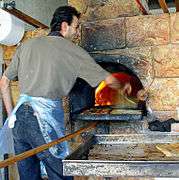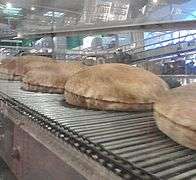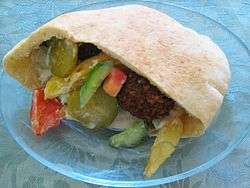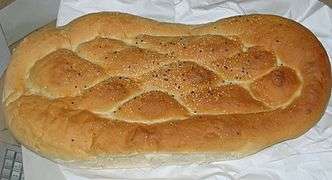Pita
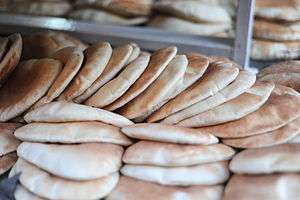 | |
| Place of origin | Middle East[1] |
|---|---|
| Main ingredients | Flour, water, yeast, salt |
Pita (/ˈpɪtə/ or US: /ˈpiːtə/)[2], sometimes spelled pitta (mainly UK), is a yeast-leavened round flatbread baked from wheat flour, sometimes with a pocket.[1]
Etymology
The first mention of the word in English cited in the Oxford English Dictionary was in 1936.[3] The English word is borrowed from Modern Greek πίτα, in turn from the Byzantine Greek πίτα "bread, cake, pie, pitta" (attested in 1108)[3] and possibly from the Ancient Greek πίττα or πίσσα "pitch/resin" (for the gloss),[4][5] or Ancient Greek πικτή (pikte), "fermented pastry", which may have passed to Latin as "picta" cf. pizza.[6][7] It was received into Levantine Arabic (as fatteh, since Arabic lacks the sound /p/).[3] Other hypotheses trace the word back to the Classical Hebrew word patt פת (literally "a morsel of bread"). It is spelled like the Aramaic pittəṭā/pittā (פיתה), from which it was received into Byzantine Greek (see above). Hypotheses also exist for Germanic[8] or Illyrian intermediaries.[9]
The word has been borrowed by Turkish as pide,[10] and appears in the Balkan languages as Serbo-Croatian pita, Romanian pită, Albanian pite, Bulgarian pitka or pita. In Arabic, the phrase خبز البيتا (pita bread) is sometimes used; other names are simply خبز 'khubz, bread' or الخبز العربي 'Arab bread' or خبز الكماج 'al-kimaj bread'.[11] In Egypt, it is called ʿaish (عيش) or ʿaish baladi (عيش بلدي).[12]
Preparation
Most pita are baked at high temperatures (450–475 °F (232–246 °C)), which turns the water in the dough into steam, thus causing the pita to puff up and form a pocket.[13] When removed from the oven, the layers of baked dough remain separated inside the deflated pita, which allows the bread to be opened to form a pocket. However, pita is sometimes baked without pockets and is called "pocket-less pita". Regardless of whether it is made at home or in a commercial bakery, pita is proofed for a very short time—only 15 minutes.[14]
Modern commercial pita bread is prepared on advanced automatic lines. These lines have high production capacities, processing 100,000 pound (45,000 kg) silos of flour at a time and producing thousands of loaves per hour. The ovens used in commercial baking are much hotter than traditional clay ovens—800–900 °F (427–482 °C)—so each loaf is only baked for one minute. The pita are then air-cooled for about 20 minutes on conveyor belts before being shipped immediately or else stored in commercial freezers kept at a temperature of 10 °F (−12 °C).[13]
Culinary use
Pita can be used to scoop sauces or dips, such as hummus, or to wrap kebabs, gyros, or falafel in the manner of sandwiches. It can also be cut and baked into crispy pita chips.
In Turkish cuisine, the word pide may refer to three different styles of bread: a flatbread similar to that eaten in Greece and Arab countries, a pizza-like dish where the filling is placed on the (often boat-shaped) dough before baking,[15] [16] [17] [18] and Ramazan pide. The first type of pide is used to wrap various styles of kebab, while the second is topped with cheese, ground meat, or other fresh or cured meats, and/or vegetables. Regional variations in the shape, baking technique, and toppings create distinctive styles for each region.
In Cyprus, pita is typically rounder, fluffier and baked on a cast iron skillet. It is used for souvlakia, sheftalia, halloumi with lountza, and gyros.
Flat breads rarely appear in Greek cuisine; the Greek word pita means "pastry". Various cakes and pastries are pitas, such as spanakopita (spinach pie) and karydopita (walnut cake). Traditional breads in Greek cuisine are leavened loaves,[19] such as the round καρβέλι karvéli or the oblong φραντζόλα frantzóla. The full name of the flat bread known in English as pita bread is aravikē pita (lit. 'Arabic pastry'), though it is also called simply "pita". In Greece, pita bread is almost exclusively used as a component of pita-souvlaki sandwich consisting of souvlaki or gyros with tzatziki, tomatoes, onions, french fries, and condiments stuffed into a pita bread pocket.
See also
- Chapati, unleavened flatbread from the Indian subcontinent
- Flour tortilla, a thin unleavened flatbread from Mexico
- Focaccia, a flat oven-baked bread from Italy
- Injera, a sourdough-risen flatbread from East Africa
- Khachapuri, a breaded cheese dish from Georgia
- Khubz, a round bread from the Arabian Peninsula
- Matnakash, a leavened bread from Armenia (related to the Ramadan pita)
- Naan, a leavened, oven-baked flatbread from Central and South Asia
- Pită de Pecica, a round bread from Romania
- Rghaif, a pancake-like bread from Northwest Africa
References
- 1 2 Marks, Gil (17 November 2010). Encyclopedia of Jewish Food. HMH. ISBN 9780544186316 – via Google Books.
- ↑ "Pita". Cambridge English Pronouncing Dictionary (18th ed.). Cambridge University Press. 2011.
- 1 2 3 "pitta". Oxford English Dictionary (3rd ed.). Oxford University Press. September 2005. (Subscription or UK public library membership required.)
- ↑ Aristotle University of Thessaloniki, Λεξικό της κοινής Νεοελληνικής
- ↑ Liddell & Scott &Jones. A Greek–English Lexicon.
- ↑ Babiniotis, Georgios (2005). Λεξικό της Νέας Ελληνικής Γλώσσας [Dictionary of Modern Greek] (in Greek). Lexicology Centre. p. 1413. ISBN 960-86190-1-7.
- ↑ The connection between picta and πηκτή is not supported by the OED s.v. 'picture' nor by Buck, Carl Darling, A Dictionary of Selected Synonyms in the Principal Indo-European Languages (1949). 9.85 "paint", p. 629
- ↑ Bracvini, G. Princi (1979). Archivio Glottologico Italiano. 64. pp. 42–89. Cited by the OED.
- ↑ Kramer, J. (1990). Balkan-Archiv. 14-15. pp. 220–231. Cited by the OED.
- ↑ Civitello, Linda (2007). Cuisine and culture: a history of food and people (Paperback ed.). Wiley. p. 98. ISBN 0471741728.
- ↑ Cauvain, Stanley (2015). Technology of Breadmaking. New York: Springer. p. 232. ISBN 978-3-319-14687-4.
- ↑ Bard, Kathryn A. (2005). Encyclopedia of the Archaeology of Ancient Egypt. London: Routledge. p. 178. ISBN 978-1-134-66525-9.
- 1 2 McNulty, Mary (2007). "Pita Bread". How products are made. Retrieved 8 May 2018.
- ↑ Tanis, David (February 21, 2014). "Homemade Pita Bread". The New York Times. Retrieved 8 May 2018.
- ↑ https://www.finedininglovers.com/blog/food-drinks/pide-recipe/ 1
- ↑ https://www.chowgofer.com/order/restaurant/turkish-cuisine-dayinin-yeri-lahmacun-menu/151 2
- ↑ https://arbuz.com/recipes/pide-recipe/ 3
- ↑ http://tastykitchen.com/recipes/main-courses/turkish-pizza-aka-kiymali-pide/ 4
- ↑ Ιφιγενεια Βιρβιδακη, Νενα Δημητριου, Νικολετα Μακρυωνιτου, Καλλιοπη Πατερα, "Tα καλύτερα ψωμιά των Αθηνών", Γαστρονόμος, Η Καθημερινή, 21.09.2016
External links


